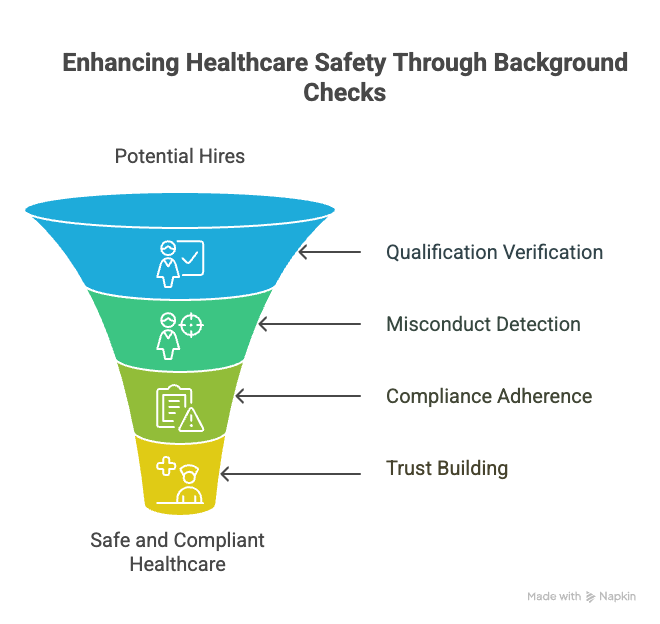In the high-stakes world of healthcare, hiring the right professionals isn’t just about ensuring quality care; it’s a matter of life and death. Background checks are an essential part of ensuring hospital staff are not only qualified but also trustworthy. This comprehensive guide will walk you through the intricacies of creating an effective background check workflow in healthcare settings, adhering to stringent compliance standards, and integrating these checks into the hospital onboarding process.
By understanding the steps involved and the legal considerations at play, you can develop a robust employee vetting system that maintains patient safety and meets regulatory demands.
Key Takeaways
- Background checks in healthcare are essential to ensure patient safety and maintain trust, making them more than standard hiring formalities.
- A comprehensive screening process should include criminal history, credential verification, employment history, and additional checks like drug testing to avoid potential risks.
- Legal compliance is crucial, requiring adherence to laws such as FCRA and HIPAA, and safeguarding candidate information to avoid penalties and maintain fairness.
- Integrating background checks into onboarding early streamlines hiring, while continuous vetting ensures ongoing compliance and safety throughout employment.
- Overcoming challenges with consistency, up-to-date regulations, and administrative efficiency can improve your hospital's hiring process for safer and more reliable staffing.
EXPERT INSIGHT: As a Human Resources practitioner, I have witnessed how much these background checks count. In healthcare space, they are not regulations—these are precautions to ensure that the patients are safe and the caretakers are going to perform their duties efficiently. Accepting a caregiver position for patients is a heavy task. These checks indicate that we are concerned about the security of the patients, believe them, and offer good health care. Having these checks by help teams is not required for my work—but it does count a lot to me because I know what could go wrong. - Charm Paz, CHRP
Introduction
In healthcare, meticulous hiring isn’t optional—it’s critical. Every decision affects patient safety and trust. Background checks are your first line of defense against potential hiring mistakes. This process isn’t just a formality; it’s tailored specifically for the high-stakes nature of healthcare.
The focus here is on creating an effective background check workflow suited for hospital environments. This means ensuring that every step caters not only to standard hiring needs but also to the stringent demands of healthcare.
We'll cover the essential elements of healthcare background screening. You'll get a clear understanding of compliance issues and practical integration strategies. Think of this as your playbook for a seamless and effective employee vetting system.
The Importance of Background Checks in Healthcare
Background checks in healthcare aren't just formalities; they're lifelines. Hospitals handle sensitive data and care for vulnerable populations, making thorough vetting mandatory. Consider the risks: an unchecked hire could jeopardize patient safety or breach data security. Background checks reduce these risks by verifying qualifications and uncovering past misconduct.
Compliance is another driver. Bodies like the Joint Commission on Accreditation of Healthcare Organizations (JCAHO) and regulations such as HIPAA demand rigorous screening to protect patients and data. Failing to meet these standards can result in penalties and loss of accreditation.
Trust is foundational in healthcare settings. Patients trust hospitals to keep them safe and treat them with qualified professionals. Staff needs that trust as well, knowing colleagues won’t undermine care or ethics. Background checks help maintain these trust links, ensuring the hospital environment is both safe and secure. Resources from the EEOC suggest that proper checks can even enhance workplace morale by fostering a transparent environment.

Is your facility doing all it can to vet potential hires? A comprehensive background check process isn't just beneficial—it's essential for maintaining a trust-based, compliant healthcare setting.
Key Components of Healthcare Background Screening
You need a solid background check plan to ensure you're hiring the right people in healthcare. Here's what to focus on:
- Criminal History: Start here. Criminal record checks are crucial. In a hospital, you're dealing with vulnerable patients. Any history of violence or fraud could lead to massive risks. Even if an offense happened years ago, it could still impact today's work environment.
- Credential Verification: You can't always trust what's on a resume. Verifying educational and professional qualifications is non-negotiable. Doctors and nurses need to meet specific standards. Fake degrees exist. Protect the integrity of your care by confirming credentials with relevant institutions.
- Employment History: This tells you if a candidate is truthful and experienced. Gaps might signal issues. Past performance often indicates future behavior. Follow up on previous employment to see if their record matches what they claim.
- Additional Checks: Don't stop at the basics. Drug testing can pinpoint potential on-the-job risks. Exclusion list checks are vital to ensure candidates haven’t been barred from other medical institutions. It might be time-consuming, but asking the right questions now can prevent problems later.
Are there aspects of your current process that could be more thorough? By missing these checks, you might unknowingly compromise both care quality and safety.
Developing a Background Check Workflow in Healthcare
Creating an effective background check workflow starts with understanding your hospital's unique needs. You need to evaluate what specific elements your institution requires, which could vary based on patient demographics, services offered, or regional laws. Tailoring your process aligns your hospital's standards with its operational realities, ensuring both compliance and relevance.
Choosing a screening service is your next priority. Look for providers with proven reliability and specific expertise in healthcare. Consider their compliance with industry standards and the scope of their checks. For instance, do they verify credentials and run criminal checks specific to healthcare professionals? Transparency in results and speed in delivery are also important.
Timing and sequence matter significantly in integrating background checks. Ideally, these checks should be initiated at offer acceptance and concluded before the start date. This sequence minimizes disruptions, allowing HR teams to address potential issues early without delaying onboarding. Clear stages in this process help maintain a smooth hiring flow.

Finally, you must establish internal policies that support this workflow. Create guidelines that articulate the steps of the background check process, addressing every phase from initial checks to re-screening intervals for current staff. Ensure these policies are in harmony with broader onboarding procedures and compliance guidelines. This clarity fosters consistency and upholds the integrity of your hiring process.
Legal Considerations and Compliance
Navigating legal landscapes is a crucial part of background checks in healthcare. Start by familiarizing yourself with the key laws. The Fair Credit Reporting Act (FCRA) governs how you collect and use background information. Compliance requires providing candidates with a clear disclosure and obtaining written consent. The Equal Employment Opportunity Commission (EEOC) also plays a role. It ensures that checks do not result in discriminatory hiring practices.
Privacy is another major concern. When handling sensitive information, safeguard the candidate’s personal data. Implement secure data storage protocols and limit access to authorized personnel. Consent is not just a formality; it’s a legal must-have. Always get clear permission before diving into a candidate’s history. This builds trust and reduces legal exposure.
Adverse action procedures are equally critical. If you decide to rescind a job offer based on a background report, follow a specific protocol. The EEOC guidelines require that you provide the applicant with a pre-adverse action notice. This includes a copy of the background check and a summary of rights under FCRA. Allow the candidate to dispute the information before making a final decision. Once the decision is made, send a post-adverse action notice explaining the outcome.
By aligning your background check practices with these laws, you protect both your organization and potential hires. It’s about more than just compliance; it’s about fostering a fair and trustworthy hiring environment.
Integrating Background Checks Into Hospital Onboarding
Integrating background checks into the hospital onboarding process early can streamline your operations significantly. It ensures that candidates are vetted before they set foot in patient areas. Starting background checks as soon as a candidate accepts an offer reduces delays. A swift transition from candidate to employee supports operational smoothness and assures compliance.
Communication is critical. HR staff must be trained to understand the nuances of background screening. They should be well-versed in compliance requirements, as this prevents legal pitfalls. Empowering staff with knowledge boosts confidence and enhances the efficiency of your onboarding process.
Continuous vetting is an emerging practice. It allows hospitals to maintain ongoing checks throughout an employee's tenure. This strategy helps ensure compliance with regulatory standards and maintains patient safety over time. Regular updates and reviews keep your workforce's integrity intact. Would periodic screenings fit within your current system, or would adjustments be necessary for effective implementation?
Challenges and Best Practices
Implementing background checks in hospitals isn't without its hiccups. First, consider consistency. Ensuring uniformity in the screening process helps avoid oversight. Without a standard procedure, critical checks might be missed, which could lead to hiring risks. For instance, while one department consistently checks exclusion lists, another might skip this step due to oversight. Consistency requires a well-documented process that everyone follows without exception.
Another challenge is keeping up with regulations. Laws change, and what was compliant last year might not be today. Regular training sessions and updates to policies help keep your team in line with current laws. Ignorance of these changes isn’t a valid excuse in audits or legal scrutiny. Engage your legal team or compliance officers regularly to bridge any knowledge gaps.
Administrative delays also pose a problem. When background checks take too long, they can choke the hiring funnel, creating staffing shortages. To combat this, review and streamline your process. Check if your provider offers fast turnaround times and if not, consider alternatives. Technology can be your friend here. Automated systems reduce the manual workload and hasten the entire process from initiation to completion.
For best practices, start with transparency. Ensure candidates know upfront what checks will be done and why. This not only builds trust but also decreases anxiety around the hiring process.
Implement a continuous check policy. Vetting shouldn’t stop after hiring. Regular checks keep you informed of any legal or professional changes concerning your staff that could affect their role.
Finally, invest in training for those conducting these checks. Well-trained staff are essential to spotting red flags that automated systems might miss, such as discrepancies in employment history or exaggerated credentials. Equipping your team with intuitive software and comprehensive training programs ensures a thorough evaluation, reducing the risk of hiring errors.
Conclusion
Background checks are the backbone of a secure hiring process in healthcare. Throughout this guide, you've learned about the fundamental components of these checks, from criminal history to employment verification. Complying with legal standards like EEOC guidelines ensures not just adherence but also reinforces the trust and safety essential in hospital settings.
Implementing a thorough background screening system reassures both patients and staff, enhancing confidence across the board. You have the tools to assess and refine your current processes. Take action now to ensure your hospital's hiring practices contribute to a safer, more reliable healthcare environment.
Additional Resources
For a deeper dive into the employment background check process, you can explore Understanding the Employment Background Check Process. This resource provides a clear overview of what you can expect when conducting background checks and may help clarify any uncertainties you might encounter. Additionally, if you're looking to fully grasp the legal aspects, the EEOC Guidelines offer comprehensive information to ensure your background check process aligns with federal regulations. These resources are essential tools to refine your approach and maintain adherence to legal requirements.
Are background checks required for hospital employees?
Yes, background checks are typically required for hospital employees. This helps ensure patient safety and trustworthiness of the staff.
Frequently Asked Questions (FAQs)
What is included in a hospital background check?
Hospital background checks often include verification of education and employment history, criminal records, drug testing, and professional license checks.
When should background screening happen during hospital hiring?
Background screening should occur after a job offer is made but before the new employee starts work. This ensures the candidate meets all the safety and compliance standards.
How do hospitals ensure background check compliance?
Hospitals ensure compliance by adhering to state and federal regulations, using certified screening services, and maintaining clear policies for staff and new hires.
How often should hospital staff be rescreened?
Hospital staff should be rescreened periodically. Annual checks are common, but the frequency might increase for roles deemed high-risk.
What are the consequences of failing a hospital background check?
Failing a background check can lead to withdrawal of a job offer or termination of employment, depending on the severity of the issue.
What happens if a staff member refuses a background check?
Refusal to undergo a background check can result in the retraction of a job offer or disciplinary action, as compliance is generally mandatory.
Do background checks differ based on hospital roles?
Yes, roles with higher responsibility, access to controlled substances, or direct patient care may require more comprehensive background checks.
Are background checks conducted for volunteers at hospitals?
Yes, background checks are also conducted for hospital volunteers to ensure a safe environment for patients and staff alike.
Definitions
Background Checks
Background checks are structured reviews of a person's history to evaluate suitability for a job. In healthcare, they often include criminal history, professional licenses, education, past employment, and drug screening. Hospitals use them to reduce liability, protect patient safety, and ensure compliance with healthcare regulations.
Credential Verification
Credential verification confirms that a candidate’s education, licenses, and certifications are valid and up to date. This is especially important in healthcare, where patient safety relies on staff being properly qualified. For example, verifying a nurse's license with the state board helps avoid hiring someone unlicensed or suspended.
Employment History
Employment history checks look into where a candidate has worked, when, and in what capacity. This helps you confirm the accuracy of a resume and detect red flags like unexplained gaps or misleading job titles. It’s a useful way to gauge reliability and past performance.
Compliance
Compliance refers to following rules and regulations set by government agencies and accrediting bodies. In healthcare hiring, this includes laws like the Fair Credit Reporting Act (FCRA) and standards from the EEOC and JCAHO. Staying compliant reduces the risk of lawsuits, fines, or losing accreditation.
Adverse Action
Adverse action is the formal process that occurs if a job offer is withdrawn based on negative information found in a background check. Employers must follow legal steps, including giving notice, sharing the report, and offering a chance to dispute inaccuracies. This protects applicant rights while allowing fair decisions.
Conclusion
Within the health care industry, every decision regarding personnel selection is of the highest significance. Background checks go beyond mere regulative compliance; they are inherently people-oriented. These steps are precautionary safeguards for patients, build rapport among staff, and confirm with our purpose of ensuring a safe, ethical work environment. Whether a person works in the personnel department, as a department director, or works to improve recruitment practices, their position is extremely important. The quality of patient care is directly related to the people we work with to provide care to others.
References
Still have questions?
Get in touch with our team today for a personalized demo and discover how our tailored volume pricing and packages can drive results for your business!
How useful was this page?*
Note: your comments are anonymous. We use them to improve the website. Do not include any personal details.
Visit our FCRA Compliance Tool or leave a message here if you need a response.
From the blog Explore the GCheck Content Hub

Level 2 Background Check for Childcare: Complete Compliance Guide for Employers
17 Dec, 2025 • 18 min read
How to Get a TWIC Card: Complete Application Guide
17 Dec, 2025 • 28 min read
Pharmacy and Medical Delivery Driver Background Checks: Compliance Guide
17 Dec, 2025 • 24 min readThe information provided in this article is for general informational and educational purposes only and should not be construed as legal advice or a substitute for consultation with qualified legal counsel. While we strive to ensure accuracy, employment screening laws and regulations—including but not limited to the Fair Credit Reporting Act (FCRA), Equal Employment Opportunity Commission (EEOC) guidelines, state and local ban-the-box laws, industry-specific requirements, and other applicable federal, state, and local statutes—are subject to frequent changes, varying interpretations, and jurisdiction-specific applications that may affect their implementation in your organization. Employers and screening decision-makers are solely responsible for ensuring their background check policies, procedures, and practices comply with all applicable laws and regulations relevant to their specific industry, location, and circumstances. We strongly recommend consulting with qualified employment law attorneys and compliance professionals before making hiring, tenant screening, or other decisions based on background check information.


